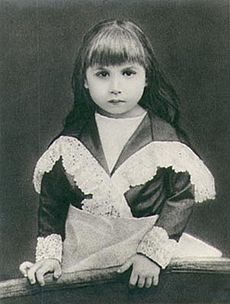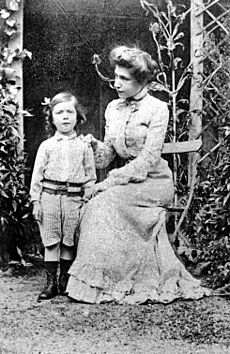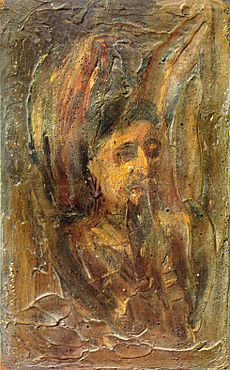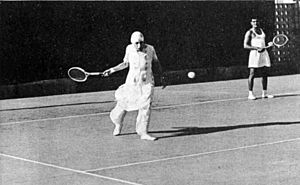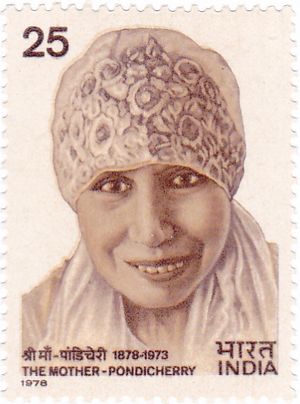Mirra Alfassa facts for kids
Quick facts for kids Mirra Alfassa |
|
|---|---|

Mirra Alfassa
|
|
| Religion | Hinduism |
| Institute | Sri Aurobindo Ashram Auroville |
| Pen name | The Mother |
| Personal | |
| Nationality | French, Indian |
| Born | Blanche Rachel Mirra Alfassa 21 February 1878 Paris, France |
| Died | 17 November 1973 (aged 95) Pondicherry, India |
| Resting place | Pondicherry, India |
| Students | Satprem, Nolini Kanta Gupta, Nirodbaran, Amal Kiran, Pavitra |
| Works | Prayers And Meditations, Words of Long Ago, On Thoughts and Aphorisms, Words of the Mother |
| Signature |  |
Mirra Alfassa (born February 21, 1878 – died November 17, 1973) was a French spiritual teacher. Her followers called her The Mother. She worked closely with Sri Aurobindo, another spiritual leader, who saw her as his equal.
Mirra Alfassa helped create the Sri Aurobindo Ashram in India. She also started Auroville, a special town meant for people from all over the world to live together in peace. Her ideas and teachings on a type of spiritual practice called Integral Yoga inspired many writers and spiritual people.
Mirra Alfassa was born in Paris in 1878 to a family with Jewish roots. When she was young, she traveled to Algeria to learn about spiritual practices. Later, in Paris, she guided a group of people interested in spirituality. In 1914, she went to Pondicherry, India, and met Sri Aurobindo. She felt she had seen him in her visions before. She helped publish a French magazine called Arya, which shared Sri Aurobindo's writings.
During World War I, she had to leave Pondicherry. After living in Japan for four years, she returned to Pondicherry in 1920 for good. As more people joined her and Sri Aurobindo, she helped organize and grow the Sri Aurobindo Ashram. In 1943, she opened a school in the ashram. In 1968, she founded Auroville, a town focused on human unity. She passed away in Pondicherry on November 17, 1973.
Her experiences from the last thirty years of her life were written down by her follower, Satprem. These conversations are found in a 13-book series called Mother's Agenda.
Contents
Discovering Mirra Alfassa's Early Life
Childhood and Family
Mirra Alfassa was born in Paris in 1878. Her father, Moïse Maurice Alfassa, was a Turkish Jew, and her mother, Mathilde Ismalun, was an Egyptian Jew. Her full name at birth was Blanche Rachel Mirra Alfassa. Her family had moved to France just a year before she was born. She had an older brother, Mattéo Mathieu Maurice Alfassa, who later worked for the French government in Africa. Mirra was very close to her grandmother, Mira Ismalum, who was one of the first women to travel alone outside Egypt.
Mirra learned to read at age seven and started school at age nine. She enjoyed many arts, tennis, music, and singing. Her mother worried because Mirra didn't seem to stick with one interest. By age 14, she had read most of the books in her father's large collection. This helped her become very good at French.
Mirra had many unusual spiritual experiences as a child. She didn't understand what they meant. She kept these experiences secret because her mother might have thought they were a problem. Mirra remembered a dream or vision at age thirteen or fourteen. In it, she saw a bright figure she called Krishna, even though she had never seen him before.
Becoming an Artist and Traveler
Art Studies in Paris
In 1893, after finishing school, Mirra went to Académie Julian to study art. Her grandmother introduced her to Henri Morisset, an artist. They married on October 13, 1897. Both were successful artists during a time when many impressionist artists were active. Their son, André, was born on August 23, 1898.
Some of Mirra Alfassa's paintings were shown in art exhibitions in Paris in 1903, 1904, and 1905. At this time, she considered herself an atheist. However, she was having many spiritual experiences that felt very real. She wanted to understand them better. She found some answers in the book Raja Yoga by Swami Vivekananda. She also received a French copy of the Bhagavad Gita, which helped her learn more about these experiences.
Meeting Max Théon
Mirra met Louis Thémanlys, who led a group called the Cosmic Movement. This group was started by Max Théon. Mirra read their magazine, Cosmic Review, and joined their discussions. On July 14, 1906, she traveled alone to Tlemcen, Algeria, to meet Max Théon and his wife, Alma Théon. She visited them two more times in 1906 and 1907. There, she practiced and experimented with their spiritual teachings.
In 1908, Mirra moved to a small apartment in Paris. She discussed ideas with Buddhists and members of the Cosmic Movement. She also met Alexandra David-Néel. In 1911, Mirra married Paul Richard, who was interested in philosophy. He had met Mirra through Max Théon.
First Visit to India and Japan
Paul Richard wanted to run for election in Pondicherry, which was then controlled by France. On March 7, 1914, Mirra and Richard sailed to India, arriving in Pondicherry on March 29. In Pondicherry, they met Sri Aurobindo. When Mirra first saw him, she recognized him as the person she had seen in her dreams. During a later meeting, she felt her mind become completely silent and free of thoughts.
Richard lost the election. He decided to publish a magazine about Sri Aurobindo's yoga, called Arya. It was published in both English and French. The first issue came out on August 15, 1914. It continued for six and a half years, and many of its articles later became books.
When World War I started, British officials worried about Indian freedom fighters in French Pondicherry. Sri Aurobindo had stopped his political activities, but he was still seen as a threat. The British asked the French government to hand over the freedom fighters. This request went to Mirra's brother, Mattéo Alfassa, who was then a foreign minister. He put the request aside, and it was never acted upon.
In 1915, the British insisted that Richard leave Pondicherry. Mirra and Richard left for Paris on February 22, 1915. A few years later, Richard was asked to promote French trade in Japan and China. Mirra went to Japan with Richard, and she never returned to Paris.
Mirra and Richard lived in Japan for four peaceful years. They met many people in the Indian community there. On April 24, 1920, Mirra returned to Pondicherry with Richard and Dorothy Hodgson. Mirra moved into a guest house near Sri Aurobindo's home. Richard did not stay long in India; he traveled around North India, then returned to France, and later remarried. He passed away in 1968. On November 24, 1920, because of a storm, Sri Aurobindo asked Mirra and Dorothy Hodgson to move into his house. Mirra began living there with other residents.
Starting the Sri Aurobindo Ashram
| Integral yoga |
|---|
Over time, many people who read the Arya magazine or heard about Sri Aurobindo came to live at his home. They wanted to practice his yoga. At first, some of the other residents didn't fully accept Mirra. However, Sri Aurobindo saw her as his equal in spiritual practice. He began calling her "The Mother," and this became her name for everyone in the community.
Around 1924, The Mother started organizing the daily life of the household. Slowly, the house became an ashram, a spiritual community, with many followers joining each day. After 1926, Sri Aurobindo began to withdraw from daily activities. He focused completely on his spiritual practices. By then, the community had grown to 85 members and had become a spiritual ashram.
Understanding Integral Yoga
On November 24, 1926, a special day known as Siddhi Day (Victory Day), The Mother and Sri Aurobindo made an important announcement. They said that a higher level of consciousness, called the "overmind," had come into the physical world. This meant that humans could now directly experience this higher consciousness. This day is still celebrated by the Sri Aurobindo Ashram.
Sri Aurobindo received some complaints about The Mother's management of the ashram. To settle this, in April 1930, Sri Aurobindo declared that The Mother would be fully in charge of all ashram activities. By August 1930, the ashram had grown to 80 to 100 residents. It was a self-sufficient community with all its basic needs met.
Sri Aurobindo and The Mother called their spiritual work and principles "integral yoga." This type of yoga was different from older forms. Instead of leaving the world to live in a monastery, followers would stay in their regular lives. They would practice spirituality in all parts of their daily activities.
By 1937, the ashram had more than 150 residents. More buildings and facilities were needed. Diwan Hyder Ali, the Nizam of Hyderabad, gave money to the ashram for this expansion. Under The Mother's guidance, architect Antonin Raymond and his team built a dormitory. World War II delayed construction, but the building, named Golconde, was finished after ten years. In 1938, Margaret Woodrow Wilson, the daughter of US President Woodrow Wilson, came to the ashram and stayed there for the rest of her life.
When World War II began in 1939, some ashram members might have supported Hitler because Britain was attacked. However, both The Mother and Sri Aurobindo publicly supported the Allied forces. They even donated to the Viceroy's war fund, which surprised many Indians.
School in the Ashram and Sri Aurobindo's Passing
On December 2, 1943, The Mother started a school for about twenty children inside the ashram. This was a big change from the ashram's usual focus on leaving the outside world behind. However, she believed the school would help children learn about Sri Aurobindo's integral yoga. The school later became known as the Sri Aurobindo International Centre of Education. Starting February 21, 1949, she began a quarterly magazine called "The Bulletin." In it, Sri Aurobindo wrote about a "supramental manifestation upon earth," describing a being between humans and superhumans.
Sri Aurobindo passed away on December 5, 1950. This was a very difficult time for The Mother. All activities in the ashram stopped for twelve days. After this, The Mother decided to take on all the work of the ashram and continue the integral yoga herself. From 1950 to 1958, she was often seen by her followers.
Life in Pondicherry, India
On August 15, 1954, French Pondicherry became a union territory of India. The Mother declared that people could have dual citizenship for both India and France. Jawaharlal Nehru, the Prime Minister of India, visited the ashram on January 16, 1955, and met with The Mother. This meeting helped him understand the ashram better. During his second visit on September 29, 1955, his daughter, Indira Gandhi, came with him. The Mother had a strong impact on Indira Gandhi, and they developed a close relationship.
The Mother continued to teach French after Sri Aurobindo's passing. She started with simple conversations, which grew into deeper discussions about integral yoga. She would read from Sri Aurobindo's or her own writings and then explain them. These sessions were later collected into a seven-volume book called Questions and Answers.
After 1958, The Mother slowly began to withdraw from outer activities. The year 1958 also marked significant progress in her spiritual practice. She stopped all public activities from 1959 onwards to focus completely on yoga. On February 21, 1963, her 85th birthday, she gave her first "Darshan" from a special terrace built for her. From then on, she would appear there on Darshan days, and thousands of visitors would gather to see her. The Mother regularly met with many followers, including Satprem. He recorded their conversations, which were later published in 13 books called Mother's Agenda.
Creating Auroville
The Mother wrote an article called "The Dream." In it, she imagined a place on Earth that no nation would own, a place for all humanity without differences. In 1964, the decision was made to build this city. On February 28, 1968, they created a plan for the city, which they named Auroville. This name means "City of the Dawn" (from the French word "aurore"). It was planned as a model universal town to help bring about human unity. The city still exists and continues to grow. Today, Auroville is managed by a foundation set up by the Indian government.
Later Years and Legacy
Many important politicians visited The Mother regularly for her advice. These visitors included V. V. Giri, Nandini Satpathy, the Dalai Lama, and especially Indira Gandhi, who stayed in close contact with her.
By the end of March 1973, The Mother became very ill. After May 20, 1973, all her meetings were canceled. She gave her final Darshan on August 15 of the same year, appearing on the outside terrace where thousands of followers waited to see her. The Mother passed away at 7:25 p.m. on November 17, 1973. On November 20, she was laid to rest in a special place called Samadhi, next to Sri Aurobindo's body, in the courtyard of the main ashram building.
Images for kids
See also
 In Spanish: Mirra Alfassa para niños
In Spanish: Mirra Alfassa para niños


